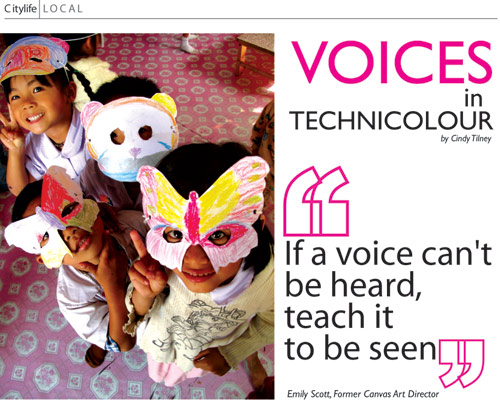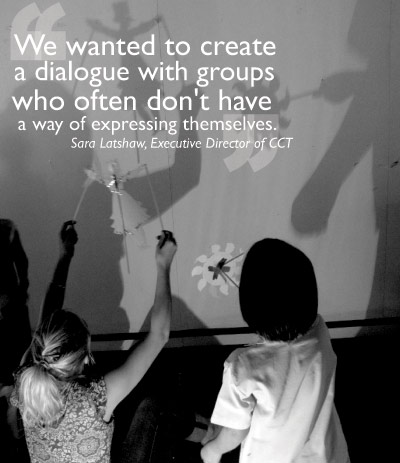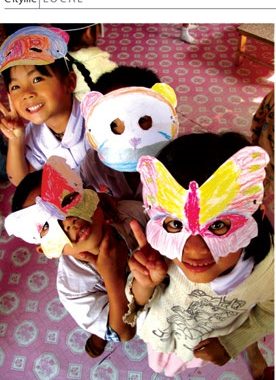
Like many foreigners who visit northern Thailand, Sara Latshaw and Zoe Lambe got stuck in Chiang Mai. Not stuck in the sense of stranded – rather, The Rose felt like a good place to set up base for a while, and hasn’t yet lost its allure for the two young women. But unlike the ubiquitous English teachers stationed around the city or the itinerant backpackers passing through, Latshaw and Lambe have done something unusual with their time here.
“When we realised we didn’t want to leave anytime soon we started looking for a way to stay in the country and contribute to it at the same time,” says Lambe. “We became aware there wasn’t much opportunity for disenfranchised groups to express themselves creatively and virtually nothing in the way of art therapy, so we came up with the vision of a volunteer arts programme.”
Both Lambe and Latshaw have a deep love of the arts and believe that creative expression nurtures innovative potential and inspires individuals to think outside the box. As a youth, Latshaw was involved in a special programme where she was allowed to go to art classes all day once a week – an experience that helped her to grow as an individual and have a greater sense of self. “Above all, the creativity I was allowed to foster in that space has enabled me to be creative throughout my life in all kinds of different areas,” she explains. “My mom’s an artist,” adds Lambe, “so art’s always been in my life and being creative is a privilege I’ve never really had to think about. But many people we work with haven’t ever had a chance to express themselves creatively before – they’re getting to do so for the first time in our workshops.”
 The pair didn’t stop at the ideas phase: in 2005 Latshaw (then 23, from the US) and Lambe (27, from Ireland) set up Cultural Canvas Thailand (CCT), a programme that utilises the skills and resources of volunteers to enrich the lives of a diverse cross-section of the Chiang Mai community. “Our goal was to promote the arts in struggling populations in Chiang Mai,” says Latshaw. “It’s important that their message is heard and art is such a great medium for people to really understand what they go through. We wanted to create a dialogue with groups who often don’t have a way of expressing themselves.” CCT now works with single mothers in need, the physically and mentally handicapped, orphans, refugees and others disadvantaged groups, offering them healing, therapy, and an artistic voice in a safe space.
The pair didn’t stop at the ideas phase: in 2005 Latshaw (then 23, from the US) and Lambe (27, from Ireland) set up Cultural Canvas Thailand (CCT), a programme that utilises the skills and resources of volunteers to enrich the lives of a diverse cross-section of the Chiang Mai community. “Our goal was to promote the arts in struggling populations in Chiang Mai,” says Latshaw. “It’s important that their message is heard and art is such a great medium for people to really understand what they go through. We wanted to create a dialogue with groups who often don’t have a way of expressing themselves.” CCT now works with single mothers in need, the physically and mentally handicapped, orphans, refugees and others disadvantaged groups, offering them healing, therapy, and an artistic voice in a safe space.
Art is just a single facet of the programme’s scope – CCT places volunteers in a kaleidoscopic range of humanitarian roles, from teachers and office assistants to grant-writers and conceptualists – but Lambe and Latshaw have stayed true to their original concept, launching the Canvas Art Project as one of their major outreach streams. The art project kicked off with a photography initiative sponsored by Lomo, in which fish eye lens cameras were distributed to the children of Burmese construction workers. The exercise culminated in a powerful photography exhibition that revealed gritty realities and poignant details of life below the radar. “In retrospect, we might have chosen something slightly less controversial as our first art venture,” smiles Lambe. “We didn’t realise the full extent of the social and political issues that these kids’ photos and stories would bring to light.”
But despite concerns that the delicate nature of the exhibition might generate a backlash from authorities, there were no repercussions and the show was met with an overwhelmingly positive response from the general public. It marked a major milestone for Latshaw and Lambe and blazed the trail for the art programme’s future – one which would encompass everything from earth building and potato printing to collage and sensory stimulation workshops. Since its inception, CCT’s creative component has been so successful that its founders are currently in the process of setting it up as an independent entity under the name of Art Relief International.
While the programme originally focused primarily on the visual arts, a series of shadow puppetry workshops at Baan Vienping Orphanage recently introduced a theatrical element. “Because the groups we work with are so diverse they have different requirements and preferences, so we do a full needs assessment before deciding what to teach,” says Lambe. “Single mothers usually prefer projects that equip them with practical skills, while kids respond better to fun stuff like finger painting and teenagers like ‘cool’ assignments like photography.” The success of the programme really comes from the volunteers, she adds: having a steady influx of new people brings with it an ongoing flood of fresh inspiration. “We get volunteers from all over the world coming to work with us for anything from three weeks to six months, which means we’re always exposed to new skills and ideas. We are constantly learning from our volunteers.”
A little over a year ago, Latshaw and volunteer art therapist Chrissy Foreman began working with Mai and Wichai, two young boys with cerebral palsy. Both had been taken in by Baan Piranan care facility after enduring severe neglect and mistreatment: Mai had been locked up in a cramped bamboo cage for years by his parents, who eventually abandoned him in a remote mountain village, while Wichai’s alcoholic father and mentally distressed mother had left him to crawl around on the ground unattended, leading to a four-metre fall down the family well which he miraculously survived. “Neither of them had ever seen paint before,” recalls Latshaw. “It was incredible to see them experiencing it for the first time, seeing colour and feeling the texture of paint. Nong Mai was just smiling and laughing and Wichai went crazy with colour, filling the whole piece of paper until there was no white space left. These are children who can’t walk, can’t talk, can’t communicate, so to be given the chance to make their own choices – even a simple choice like using red or yellow paint – is huge for them.”
In November last year, CCT organised an exhibition of the boys’ paintings, pastel drawings, umbrellas, lanterns and cardboard sculptures in an exhibition called UNCAGED: The Art of Ability. Once again, the show was a resounding success, with more than 200 people attending and over 40 artworks sold on opening night. Over 45,000 baht was raised in painting sales and donations for the continued support of Baan Piranan and the Canvas Art Program and also led to the sponsorship of over 10 wheelchairs, one of which was sponsored by Citylife, for Freedom Wheelchairs valued at over 100,000 baht. “But perhaps more substantial than any amount of money was the power that UNCAGED gave Mai and Wichai,” says former CCT volunteer Aimee Aubin. “Two voiceless boys, once subjugated to treatment worse than most people would inflict on animals, were given a voice too loud to ignore.”
In the CCT pipeline at the time of writing was a photography exhibition, “Where I Belong”, which will showcase images by 15 children (aged 10 to 16) who have lost their parents to HIV/AIDS and been taken in by their grandparents. With a camera, a roll of film and the assignment to take pictures of “what family means to you,” the children have created a window into their lives and their sense of belonging. The exhibition ‘Where I Belong’ will visit the following international schools and stay in each one for a week: NIS on March 8th, Prem on March 15th and CMIS on March 22nd. Proceeds will go directly to the sponsorship of the young photographers.
How You Can Help:
Cultural Canvas Thailand and Art Relief International are looking for volunteers from a wide range of backgrounds and experiences who are interested in contributing to social change through the arts. Volunteers help conceive and construct new art projects, build curriculums, write compelling messages to donors and work with local organisations to creatively promote their missions. To learn more go to www.culturalcanvas.com or www.artrelief.net.

